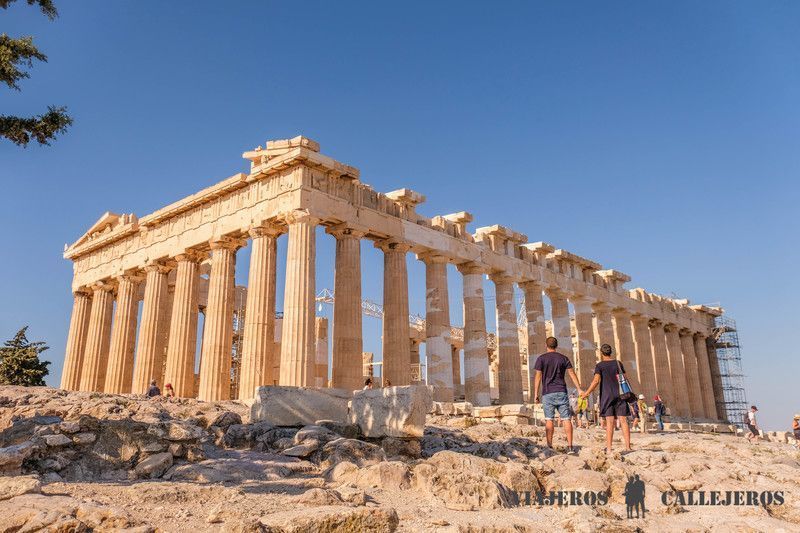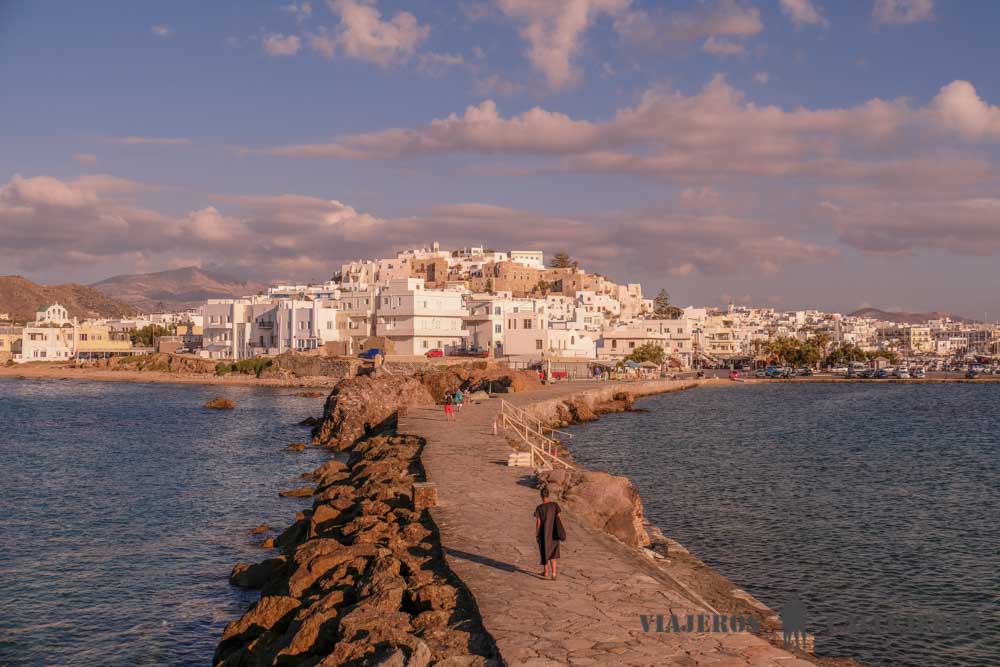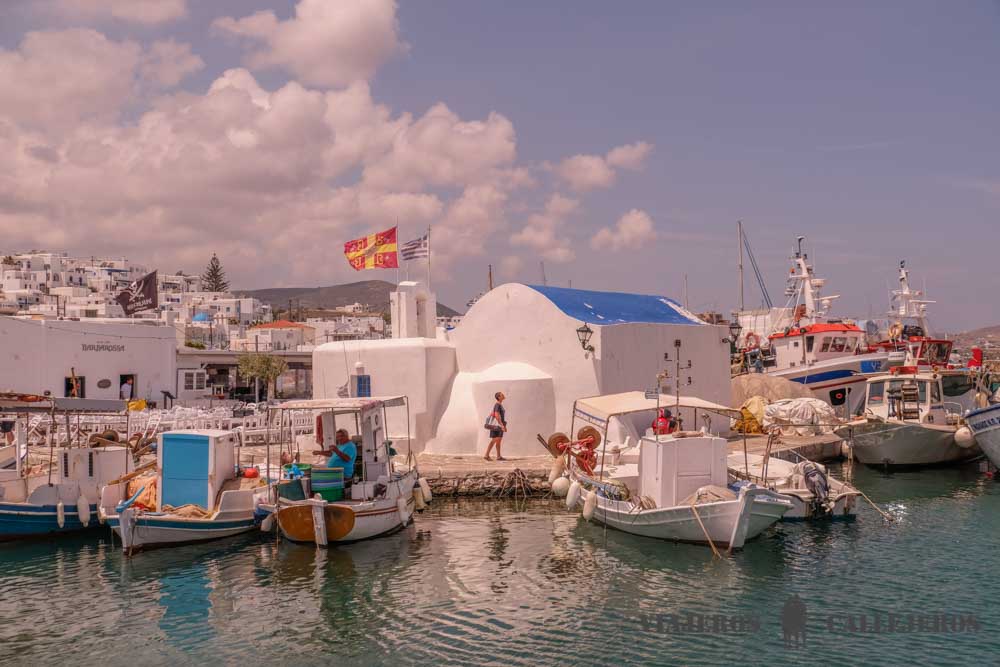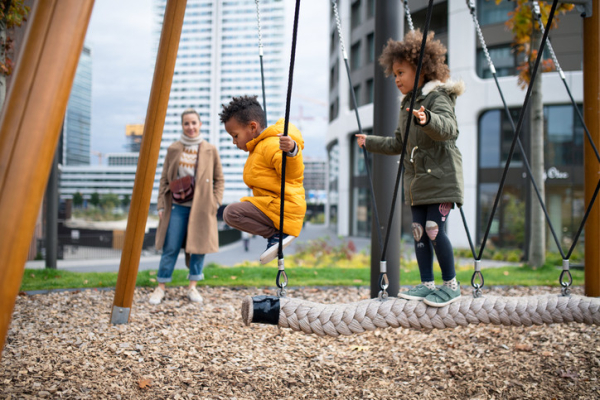Con esta guía de Grecia esperamos poder ayudarte a organizar tu viaje a uno de los países más impresionantes del mundo que además tiene una de las historias más fascinantes del planeta.
Ubicado en el sureste de Europa y con unos once millones de habitantes, Grecia tiene siete archipiélagos, con alrededor de 1400 islas, de las que 227 están habitadas, algo que lo convierte en un país increíblemente atractivo para los viajeros, no solo por su cultura sino también por la posibilidad de descubrir algunas de sus islas más turísticas como Santorini o Mykonos o algunas más tranquilas como Paros o Naxos, en las que pese al turismo, podrás retroceder en el tiempo.
Esto unido a que sea cuál sea tu destino en este país, podrás disfrutarás de la amabilidad griega y como no, su deliciosa gastronomía, hacen de este país un destino perfecto para pasar tus vacaciones.
Si tu idea es hacer un recorrido por Grecia continental, te recomendamos hacerlo en unos 10-14 días para conocer los puntos más importantes, aunque por supuesto este tiempo se puede reducir quitando algunas visitas.
Si quieres visitar también alguna isla, es recomendable añadir al itinerario unos 7 días, que te permitirán hacer la visita a 2-3 islas dependiendo de las distancias.
En total, para un viaje super completo, que incluya cultura, paisajes e islas, creemos que 21 días sería lo idóneo.
Basándonos en la ruta que realizamos por el país durante el viaje a Grecia, te dejamos esta Guía de Grecia con toda la información para que puedas preparar tu viaje. ¡Empezamos!
Guía de Grecia
En la guía de Grecia podrás encontrar todos los artículos que hemos publicado sobre el país, en los que hablamos de temas como los lugares que no puedes perderte, rutas optimizadas por días, recintos arqueológicos imprescindibles, además de posts exclusivos sobre las islas que visitamos, en los que incluimos todos los detalles para que tu viaje sea lo más increíble posible.
Con todos esperamos poder ayudarte a que la organización de tu ruta por Grecia sea inolvidable.
Qué ver y hacer en Grecia
Antes de decidir cuántos días quieres viajar es importante saber qué lugares quieres visitar en Grecia para poder así determinar cuál es la duración más adecuada para tu viaje.
Además de esto es muy interesante tener claros que lugares son los más interesantes en cada ciudad, para también así decidir cuáles quieres incluir o no y hacer un viaje a tu medida.
Para que esto sea más fácil, en la guía de Grecia te dejamos los siguientes artículos que esperamos, te ayuden con los preparativos del viaje.
Viaje a Grecia10 lugares que ver en Grecia imprescindibles10 consejos para viajar a GreciaDónde dormir en Grecia
 Guía de Grecia
Guía de Grecia
Rutas por Grecia
Para que sea mucho más fácil organizar tu viaje, te dejamos varias rutas e itinerario por el país y las islas que estamos seguros, te podrán ayudar.
Ruta por las Islas Griegas en 7 días (itinerario + mapa)Rutas e itinerarios por Grecia en 7 y 10 días
Atenas
Con más de 3000 años de historia Atenas es sin lugar a dudas un imprescindible en cualquier viaje a Grecia. Aunque no son pocos los viajeros que tienen por ella un sentimiento de amor-odio, difícil de explicar y entender, nosotros después de la experiencia, te aseguramos que probablemente sea más el amor el primero de los sentimientos en el que te atrape y te despidas de ella únicamente pensando en volver.
Perderse por la impresionante Acrópolis, recorrer los barrios de Plaka, Monastiraki y Anafiótika o disfrutar de un atardecer único desde el monte Licabeto, son solo algunas de las cosas que te regalará esta impresionante ciudad.
Siempre que puedas te recomendamos dedicar 2 o 3 días a conocerla, ya que aunque no lo parezca y todos los lugares de interés estén relativamente cerca unos de otros, Atenas tiene muchísimo que ver y ofrecer.
Para que puedas organizar tu viaje a la capital, en la guía de Grecia te dejamos toda la información que publicamos sobre Atenas y que te ayudará a planificar tu estancia en la ciudad.
Guía de AtenasAtenas en un díaAtenas en 2 díasAtenas en 3 díasLos 10 mejores tours y excursiones desde AtenasLos mejores free tours en Atenas gratis en españolDónde alojarse en Atenas: mejores barrios y hotelesDónde comer en Atenas: 10 restaurantes recomendados10 consejos para viajar a Atenas imprescindibles
 Información sobre Atenas en la Guía de Grecia
Información sobre Atenas en la Guía de Grecia
Yacimientos arqueológicos de Grecia
Para muchos viajeros, uno de los grandes motivos para viajar a Grecia, es conocer algunos de sus yacimientos arqueológicos más importantes como Delfos, Corinto, Epidauro o Micenas entre otros muchos.
Recorrerlos te permitirá conocer además de su fascinante historia retroceder en el tiempo y sentirte por unas horas, 3000 años atrás.
En la guía de Grecia incluimos un enlace a todos los que nosotros visitamos y que creemos, son los más importantes del país.
Antigua Corinto y coche de alquiler en GreciaVisitar Micenas en GreciaVisitar el Teatro de Epidauro en GreciaQué ver en Olimpia en GreciaVisitar el Monasterio Hosios LoukasVisitar el Oráculo de DelfosAtardecer en el Cabo Sounion en Grecia
 Delfos, uno de los imprescindibles en esta guía de Grecia
Delfos, uno de los imprescindibles en esta guía de Grecia
Meteora
Ubicado en el norte de Grecia, este valle es conocido por ser el lugar en el que hace más de 7 siglos se construyeron varios monasterios, declarados Patrimonio de la Humanidad, sobre rocas a más de 600 metros de altura.
En su momento llegaron a ser 24 monasterios, aunque durante la Segunda Guerra Mundial se destruyeron algunos, quedando a día de hoy 13 monasterios, de los que únicamente se pueden visitar 6 de ellos.
Aunque hay viajeros que llegan hasta aquí desde Atenas para visitarlos en un día o hacen una parada de un día después de una ruta por Grecia Continental, nosotros te recomendamos siempre que puedas, quedarte 2 o 3 días, ya que este es uno de los lugares más mágicos y fascinantes del país, del que estamos seguros, te llevarás un recuerdo imborrable.
Para que conozcas todos los lugares que se pueden visitar y las cosas que hacer en Meteora, en la guía de Grecia te dejamos un par de posts que publicamos con todos los detalles de este impresionante lugar.
Visitar los Monasterios de Meteora en GreciaQué ver en Meteora
 Meteora, uno de los lugares que no podían faltar en la guía de Grecia
Meteora, uno de los lugares que no podían faltar en la guía de Grecia
Islas Griegas, un imprescindible que no puede faltar en la guía de Grecia
Divididas en siete archipiélagos, Grecia tiene 227 islas habitadas, en las que las aguas de color turquesa, los pueblos de casas blancas salpicadas de buganvillas y los acantilados imposibles son los auténticos protagonistas junto a sus amables gentes y como no, una gastronomía que te aseguramos, está entre las más deliciosas del mundo.
Sabiendo que es imposible visitarlas todas y que la mayoría de viajeros conocen 2 o 3 en su viaje, en esta guía de Grecia te dejamos un post en el que hablamos sobre cuáles son las mejores islas griegas para que puedas escoger cuál quieres visitar.
Las 10 mejores Islas Griegas10 consejos para viajar a las Islas Griegas imprescindibles
 Mykonos, una de las islas griegas imprescindibles
Mykonos, una de las islas griegas imprescindibles
Santorini
Ubicada en el archipiélago de las Cícladas, Santorini es sin lugar a dudas una de las islas más famosas del mundo además de ser una de las imágenes de postal por la que la mayoría de viajeros suspiran cuando piensan en Grecia.
Formada tras una erupción volcánica, la isla tiene actualmente forma de media luna y una orografía totalmente distinta al resto de las islas de esta zona del mundo, en la que destacan sus pueblos blancos, que parecen estar colgados en los acantilados, salpicados por las famosas cúpulas azules, que todos los viajeros ansían en sus fotos.
Si quieres conocer bien la isla, te recomendamos dedicar unos 3-4 días mínimo para poder así conocer además de los pueblos más famosos, algunos de los pueblos del interior y hacer un par de trekkings, el de Fira a Oía y el de la Roca Skaros, en Imerovigli, que te aseguramos es impresionante.
Para que puedas organizar tu visita a Santorini, en la guía de Grecia te dejamos la guía que publicamos de la isla en la que puedes encontrar posts en los que hablamos sobre los traslados, sobre los lugares que no puedes perderte en Santorini, recomendaciones sobre alojamiento, restaurantes…etc.
Guía de SantoriniQue ver y hacer en SantoriniDónde alojarse en Santorini: mejores zonas y hoteles10 restaurantes donde comer en Santorini baratoCómo ir de Atenas a Santorini (ferry o avión)
 Santorini, una isla imprescindible en la guía de Grecia
Santorini, una isla imprescindible en la guía de Grecia
Mykonos, un destino que no puede faltar en la guía de Grecia
Ubicada también en el archipiélago de las Cícladas, Mykonos es conocida por su vida nocturna y sus fiestas aunque te aseguramos que esto no es solo por lo que destaca la isla. Es más, nos atrevemos a decir que este sería su punto más flojo si lo comparamos con la belleza de Chora, su capital, en la que te aseguramos, te sentirás como dentro de una foto de catálogo de agencia de viajes.
Si tenemos en cuenta todos los lugares que se pueden visitar en la isla, si es posible te recomendamos dedicar 3 días para conocer lo más importante y llevarte una impresión completa de la isla.
Para ayudarte con la organización de tu estancia en la isla, en la guía de Grecia también incluimos una guía de Mykonos, en la que incluimos artículos sobre los traslados, lugares que no puedes perderte, recomendaciones sobre alojamiento, restaurantes…etc.
Guía de MykonosQue ver en MykonosDónde alojarse en Mykonos: mejores zonas y hotelesDónde comer en Mykonos: 10 restaurantes recomendadosCómo ir de Atenas a Mykonos
 Mykonos
Mykonos
Naxos
Conocida por ser la isla más grande de las Cícladas, Naxos es una combinación de la belleza de Santorini y Mykonos con la tradición y tranquilidad de las islas griegas menos visitadas.
Además de todos los lugares que puedes ver en la isla, entre los que destacan pueblos anclados en el tiempo y algunas playas vírgenes espectaculares, su capital es una de sus grandes joyas, con un centro histórico bellísimo y la gran puerta o Portará que se conserva del antiguo templo de Apolo, desde donde se viven unos atardeceres inolvidables.
Al igual que en el resto de islas que hemos mencionado, te recomendamos dedicar 3-4 días si quieres conocerla y disfrutarla con un poco de tranquilidad, algo que creemos, es imprescindible en un lugar como Naxos.
Para que sea más fácil organizar tu estancia en Naxos, en la guía de Grecia te dejamos un par de posts en los que hablamos sobre el traslado y sobre los lugares que no puedes perderte en la isla.
Ferry de Mykonos a Naxos en GreciaFerry de Naxos a ParosQué ver y hacer en Naxos
 Naxos
Naxos
Paros, una isla que no puede faltar en la guía de Grecia
En pleno mar Egeo, Paros es conocida por sus bellísimos pueblos tradicionales como Naoussa y por su capital Parikia, en la que podrás disfrutar de la tradicional arquitectura griega además de como no, una gastronomía deliciosa, que se extiende por todo el país.
Como Naxos, Paros es también más tranquila que Santorini o Mykonos y aunque sus playas no son las más hermosas del mundo, algunas como Kolymbithres, son perfectas para pasar un día de relax a orillas del mar.
Nuestra recomendación es pasar 2-3 días en la isla y si tienes un día extra dedicarlo a Antiparos, una isla muy cercana, que puedes conocer perfectamente en un día.
Te dejamos estos artículos en la guía de Grecia en los que hablamos sobre el traslado a esta isla además de sobre las cosas que no puedes perderte.
Ferry de Naxos a ParosFerry de Paros a SantoriniQue ver y hacer en Paros
 Naoussa en Paros, uno de los pueblos más bellos de la isla
Naoussa en Paros, uno de los pueblos más bellos de la isla
Iremos ampliando la información de la guía de Grecia a medida que vayamos visitando nuevos lugares del país.
¿Quieres organizar un viaje a Grecia?
Consíguelo aquí:

 Las mejores ofertas de Vuelos a Grecia aquí
Las mejores ofertas de Vuelos a Grecia aquí

 Los mejores hoteles a los mejores precios en Grecia: aquí
Los mejores hoteles a los mejores precios en Grecia: aquí

 Reserva tu seguro de viaje con un 5% descuento aquí
Reserva tu seguro de viaje con un 5% descuento aquí

 Reserva los mejores tours y excursiones en Grecia en español aquí
Reserva los mejores tours y excursiones en Grecia en español aquí

 Reserva tu traslado Aeropuerto⇆Atenas aquí
Reserva tu traslado Aeropuerto⇆Atenas aquí

 Alquila tu coche para viajar por Grecia al mejor precio aquí
Alquila tu coche para viajar por Grecia al mejor precio aquí

 Reserva el ferry para las Islas Griegas al mejor precio aquí
Reserva el ferry para las Islas Griegas al mejor precio aquí





 If you have ever engaged with someone truly curious, then you know you have been graced with a compelling experience. Can you remember how that felt? They looked into your eyes—really looked—and when you spoke, they
If you have ever engaged with someone truly curious, then you know you have been graced with a compelling experience. Can you remember how that felt? They looked into your eyes—really looked—and when you spoke, they  Let’s go even further to take a look at curiosity through the lens of researchers. In a
Let’s go even further to take a look at curiosity through the lens of researchers. In a Practice: “Tell me more…”
Practice: “Tell me more…”
 Guía de Grecia
Guía de Grecia 
 Información sobre Atenas en la Guía de Grecia
Información sobre Atenas en la Guía de Grecia
 Delfos, uno de los imprescindibles en esta guía de Grecia
Delfos, uno de los imprescindibles en esta guía de Grecia
 Meteora, uno de los lugares que no podían faltar en la guía de Grecia
Meteora, uno de los lugares que no podían faltar en la guía de Grecia
 Mykonos, una de las islas griegas imprescindibles
Mykonos, una de las islas griegas imprescindibles
 Santorini, una isla imprescindible en la guía de Grecia
Santorini, una isla imprescindible en la guía de Grecia
 Mykonos
Mykonos
 Naxos
Naxos
 Naoussa en Paros, uno de los pueblos más bellos de la isla
Naoussa en Paros, uno de los pueblos más bellos de la isla
 Las mejores ofertas de Vuelos a Grecia aquí
Las mejores ofertas de Vuelos a Grecia aquí
 Los mejores hoteles a los mejores precios en Grecia: aquí
Los mejores hoteles a los mejores precios en Grecia: aquí
 Reserva tu seguro de viaje con un 5% descuento aquí
Reserva tu seguro de viaje con un 5% descuento aquí
 Reserva los mejores tours y excursiones en Grecia en español aquí
Reserva los mejores tours y excursiones en Grecia en español aquí
 Reserva tu traslado Aeropuerto⇆Atenas aquí
Reserva tu traslado Aeropuerto⇆Atenas aquí
 Alquila tu coche para viajar por Grecia al mejor precio aquí
Alquila tu coche para viajar por Grecia al mejor precio aquí
 Reserva el ferry para las Islas Griegas al mejor precio aquí
Reserva el ferry para las Islas Griegas al mejor precio aquí

